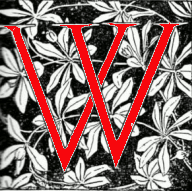Walter Crane, RWS (1845-1915): A Brief Biography (original) (raw)
Walter Crane in 1897, by William Rothenstein.
[Click on the image for more information.]

alter Crane was born on 15 August 1845 in Liverpool, Lancashire, the second son of Thomas Crane, a portrait painter, miniaturist, and a member of the Liverpool Academy, and his wife Marie Kearsley. The family moved to Torquay for the sake of his father's health when Crane was a boy. They resided there until 1857 when they moved to London. Walter's father encouraged him to pursue his interest in art and he received his first instruction in art in his father's studio. From 1859-62 Walter was apprenticed to the wood engraver W.J. Linton. Crane continued to work as an illustrator following his apprenticeship. In 1862 he exhibited his first work at the Royal Academy, The Lady of Shalott. In 1863 he met Edmund Evans, a pioneer in colour woodblock printing. Crane's reputation as an illustrator of children's books was founded on the enormously popular coloured illustration work he did for cheap sixpenny and shilling books printed by Evans and published by Routledge between 1865 and 1875. In 1865 he was first exposed to the art of Edward Burne-Jones at the Old Water-Colour Society exhibition. At about this same time he was first exposed to the art of Japan when he was given a volume of coloured wood block prints by a friend who had recently returned from that country and which would subsequently influence Crane's future designs for children's book illustrations.
In 1866 Crane began to exhibit at the Dudley Gallery. In 1871 he was introduced to Edward Burne-Jones, William Morris, Philip Webb, William De Morgan, and Edward J. Poynter at the home of George Howard. On 6 September 1871 he married Mary Frances Andrews and the couple left on honeymoon for Italy, not returning to London until 1873. Crane spent time in Venice, Florence and Naples before spending two successive winters in Rome. In Rome in the winter of 1872 Crane became better acquainted with Frederic Leighton, who introduced him to Giovanni Costa. Both artists were later to exert an influence on his work. In 1877 he was invited to exhibit at the first Grosvenor Gallery exhibition. In 1882 he was elected a member of the Institute of Painters in Water Colours but he resigned in 1886. He became a socialist in 1884 and was an active member of various socialist organizations.
In 1888 he was elected an associate of the Royal Society of Painters in Watercolours and became a full member in 1903. He co-founded the Arts and Crafts Exhibition Society and became its first president, serving from 1888-93, and then again later from 1896-1912. He was member of the Art Workers' Guild from 1884 and served as its master in 1888-89. He was part-time Director of Design at the Manchester Municipal School of Art from 1893-97. He became art director of Reading College in 1896. In 1898 he became Principal of the Royal College of Art, South Kensington. In 1905 he received the Albert Gold Medal at the Society of Arts.
Walter Crane died in Horsham Hospital, Horsham, West Sussex, on 14 March 1915, nearly three months after the death of his wife Mary. His body was cremated at the Golders Green Crematorium where his ashes were interred. Crane was an extremely versatile artist being a painter, illustrator, designer, craftsman and sculptor — and, later in his career, an author, principally of works about design.
Bibliography
Crane, Walter. An Artist's Reminiscences. London: Methuen & Co., 1907.
Konody, Paul G. The Art of Walter Crane. London: George Bell & Sons, 1902.
O'Neill Morna. Walter Crane. The Arts and Crafts, Painting, and Politics, 1875-1890. New Haven and London: Yale University Press, 2010.
Smith, Greg and Sarah Hyde. Walter Crane 1845-1915. Artist, Designer and Socialist. London: Lund Humphries, 1989.
Spencer, Isobel. Walter Crane. New York: Macmillan Publishing Co. Inc., 1975.
"Walter Crane." The Art Amateur IX (November 1883): 115-16.
Created 14 November 2025
